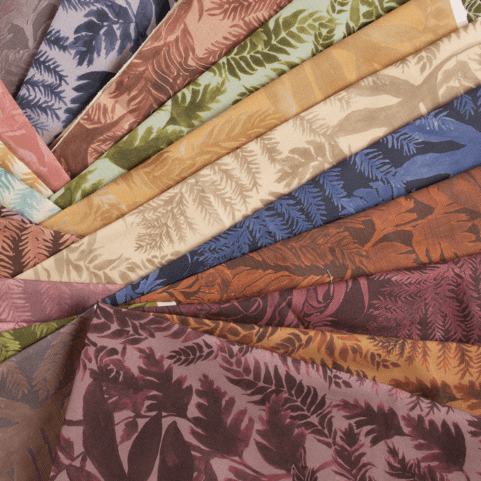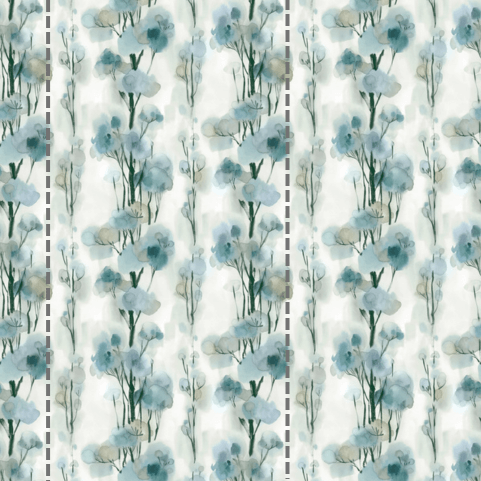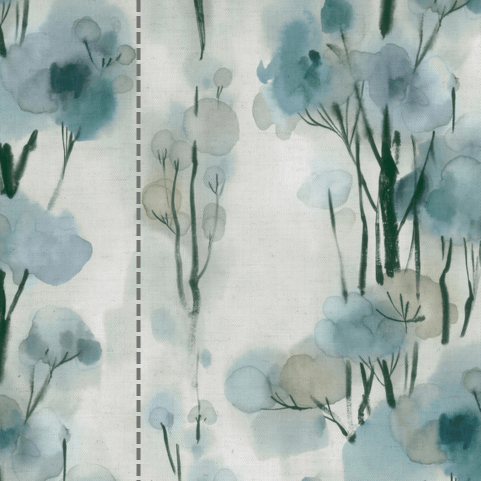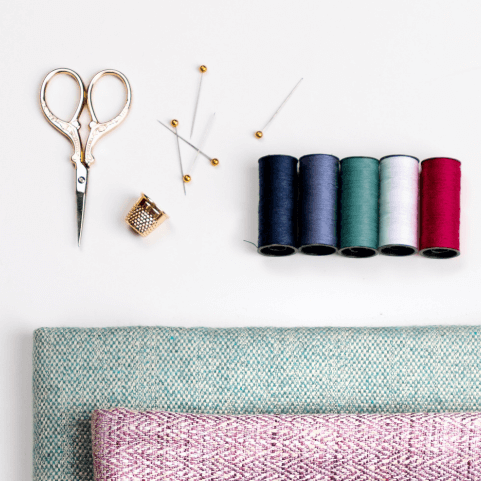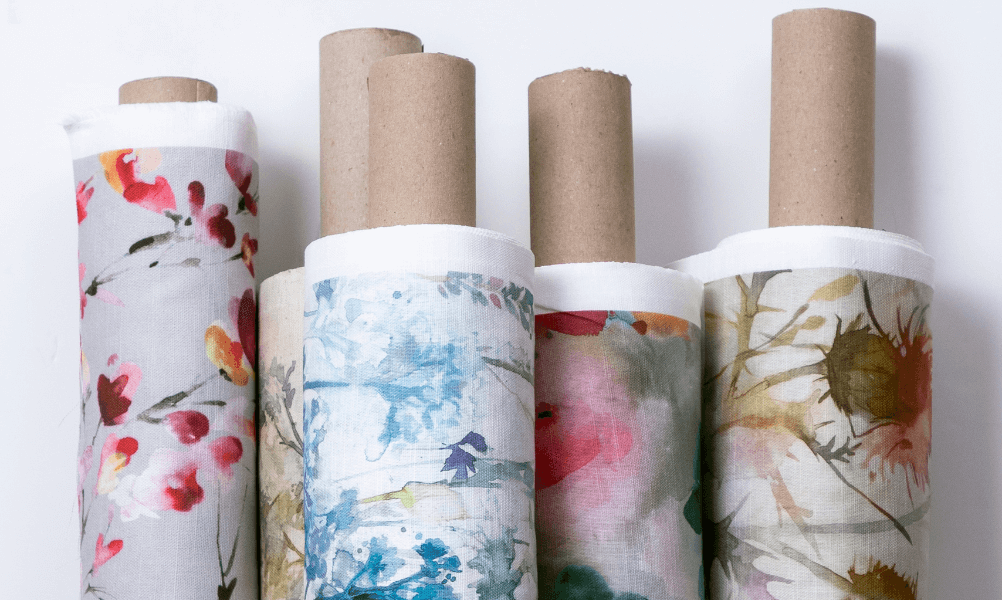In the realm of DIY upholstery and soft furnishings, knowing how to pattern match fabric is a pivotal skill that can really elevate your projects to the next level. As enthusiasts of luxury interiors and quality finishes, we understand the excitement and creativity that comes with using patterned fabrics to elevate your living spaces. Whether it's the charm of florals, the elegance of plain and textured designs, or the bold allure of maximalist prints, each pattern contributes to the overall ambience of your home. In this guide, we’ll discuss everything you need to know about how to join patterned fabric for a professional finish.
Before we learn how to match patterned fabric, it’s important to acquaint yourself with the diverse range of patterns, prints, and fabrics available. When it comes to luxury interiors, patterns can be used to bring a touch of sophistication or creativity to your space, and with our watercolour inspired designs, painted in-house by our talented team of designers, you can transform your home into a masterpiece.
Delve into the intricacies of florals, the simplicity of plain patterns, and the bold statements made by maximalist motifs or the rustic warmth of country prints. With a variety of designs, styles, and premium materials, it’s easy to elevate your interior. Discover patterned linens, sumptuous velvets, and luxurious chenille, and find the perfect piece for your next home project.
It’s important to understand how these different patterns can influence the pattern matching process to ensure you choose the right one to complete your home décor. Each pattern type, whether florals, coastal prints, abstract, or country-inspired designs, comes with its own intricacies. The size, repetition, and nature of each pattern varies, influencing where and how you match them. For instance, florals often have a specific repeat point, like the centre of a flower, which can guide your matching decision, while coastal prints usually have flowing elements that need careful alignment for a seamless look. On the other hand, abstract patterns usually offer more flexibility, but even they still require consideration of continuity. When it comes to pattern matching your fabric, you should always look to identify distinctive elements, recognise any natural gaps in the pattern, and select strategic points to join for a flawless finish.
Creating a harmonious and seamless look in your home is an art, and knowing how to pattern match fabric is the key to achieving that flawless aesthetic for each of your upholstery or textile projects.
Identify the Pattern Repeat
Before you join your fabric it’s important to have a good look at it to work out where the pattern repeat is. A pattern repeat refers to the point at which a design or pattern on a fabric repeats itself. In textile design, patterns often have a specific arrangement that repeats at regular intervals horizontally and vertically, and this will usually be marked with a distinctive element within the print. To find the pattern repeat, lay your chosen fabric down so you can see the pattern clearly, and start examining the print from the edge. Going from the edge inwards, find a distinctive element within the pattern such as a large flower or motif, it should be easily recognisable and close to the fabric edge.
Decide Where to Join
To achieve a perfect pattern match, carefully choose where to join the fabric. Opt for a noticeable part of the pattern that is part of a natural gap, avoiding overly conspicuous elements. For example, you wouldn’t want to join down the edge or middle of an element as any slight misalignments would stand out. Instead, move to the side of it and find a plain area, this may be where two leaves meet on a floral print, or between two animals in a country print. If you’re uncertain about where to pattern match, don’t hesitate to fold the fabric in different areas to get an idea of how it would look once joined.
Prepare the Fabric for Pattern Matching
Now you’ve identified the repeat and know where you’re going to join the fabric, it’s time to prepare for matching. Begin by cutting the backing fabric in half lengthwise. Fold one piece at the chosen pattern-matching point, pressing it in place. Lay the other piece with the right sides facing up on a flat surface. Once you have both pieces in place, place the folded edge of the first piece's right sides together with the second piece, lining up the pattern on the fold. Make sure the pattern matches along the fold, gently open it out and pin the fabric into position, focusing on any distinctive markers you recognise.
Pinning the Fabric
Next, it’s time to pin your fabric to ensure it stays even when you’re sewing. It’s often easier to pin the fabric in two stages for more precision. Start by pinning within the crease line, this way you can still fold back the edge and check that the pattern is still matched and nothing has been shifted out of place. We recommend that you then pin horizontally between the other pins to ensure that as you’re sewing along the seam, everything is kept in place.
If you’re finding it difficult to pin things in place or are dealing with particularly heavy or long fabrics, it can be helpful to use double-sided tape. This helps to provide additional stability, preventing the fabric from shifting. Place it to the right side of the fold, on the side furthest from the fabric edge and then peel off the top layer when ready and press the fabrics together. If you think you still need a bit more stability, then you can follow up with a few extra pins.
Once you’ve ensured your fabric is aligned correctly and is pinned securely in place, it’s time to join it. It’s important that you know how to join patterned fabric correctly and to do so we recommend the use of a sewing machine and walking foot. This specialised foot helps feed multiple layers of fabric evenly, helping to reduce the risk of your fabric shifting.
Once you have your machine set up, choose a thread colour that complements or blends in with the fabric. Set up your thread and select a stitch suitable for your fabric type and start feeding your fabric through, sewing the lengths together. We always recommend stopping periodically to check that the pattern matching is consistent along the entire seam. If you find any inconsistencies, you can undo a small section and restitch it to ensure the pattern is matched perfectly. Continue sewing until the end of the seam and then backstitch at the beginning and end to secure everything in place. Once you’re satisfied with the pattern match you can trim any excess fabric from the seam allowance for a clean finish.
After learning how to pattern match fabric, you may think it seems straight forward enough, however it does come with its fair share of common challenges. Understanding any potential hurdles and knowing the solution for each is key when learning how to join patterned fabric and achieve a flawless outcome in your home décor.
Pattern Distortions
One common challenge is dealing with pattern distortions, especially in fabrics with intricate designs. To overcome this, pay careful attention when aligning and secure the fabric with your pins, keeping an eye on the natural flow of the pattern. Regular checks during sewing help catch any deviations.
Misalignment Along Seams
Ensuring a consistent pattern match along seams poses another challenge. Pinning strategically and using markers in the pattern can help maintain alignment. Take as much time as you need to adjust and readjust, this part is all about patience!
Matching Complex Designs
Joining patterned fabrics that show intricate detailing may present challenges in achieving a seamless match. Remember to identify focal points within the design and use them as reference points when you’re aligning your fabric. This approach simplifies the process and enhances precision.
Fabric Shifting During Sewing
Heavier fabrics or longer lengths may be prone to shifting during sewing which can lead to misalignments in your joins. By employing techniques such as double-sided sticky tape in addition to pins to stabilise each layer you can keep everything secure and aligned.
Importance of Finishing Touches
When it comes to pattern matching fabric, the devil is in the details. The finishing touches really do make all the difference when perfecting the overall look. Take the time to trim any excess fabric from seam allowances, ensuring a polished and professional appearance.
Navigating these common challenges with a keen and strategic eye ensures that your pattern matching efforts are all worth it in the end, leaving you with an outcome that’s both visually stunning and cohesive.
Now that you know all you need to about how to pattern match fabric, it’s time to get creative! Explore a range of premium fabrics in our collection that can be used for upholstery, textiles, clothing, and more, and order a free sample to find the perfect print for your next interior project. Looking for inspiration for your next project? Check out our Ideas for Scrap Fabric Projects! Follow this step-by-step guide on pattern matching and create a home interior that’s personalised to you and take the time to appreciate the beauty of seamlessly aligned patterns, transforming your living spaces into a visual masterpiece.



